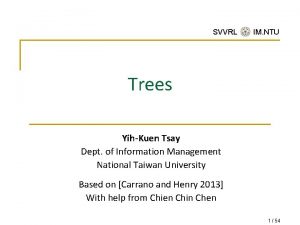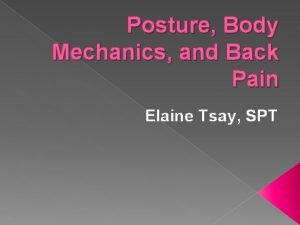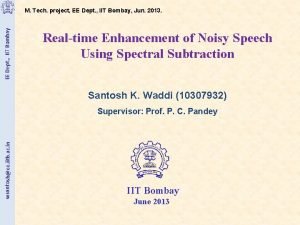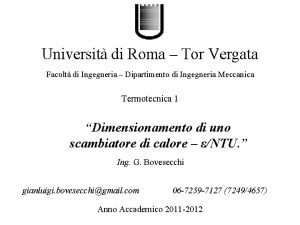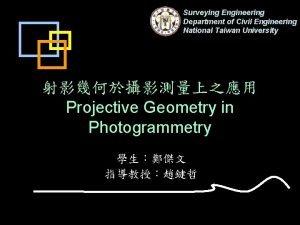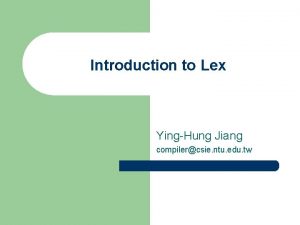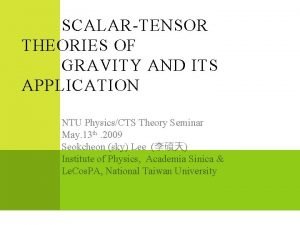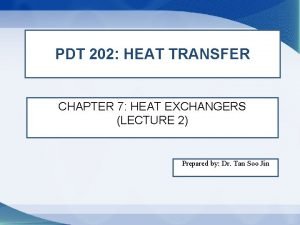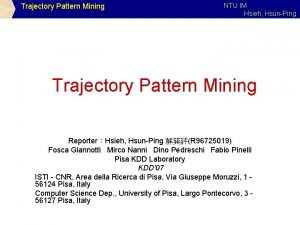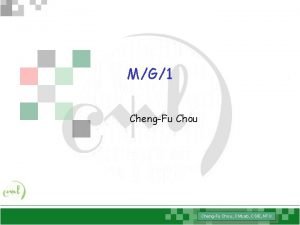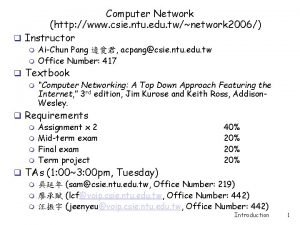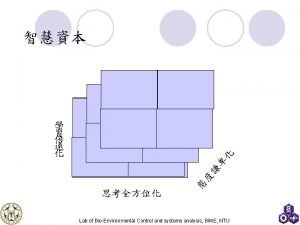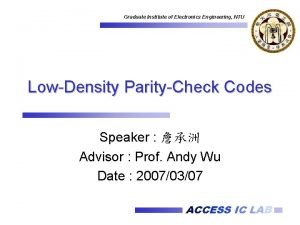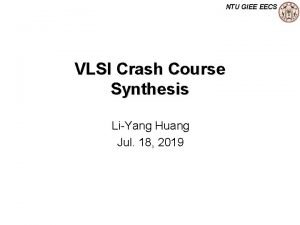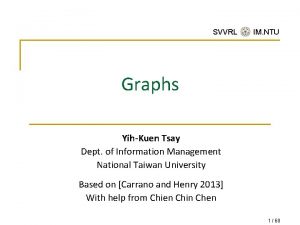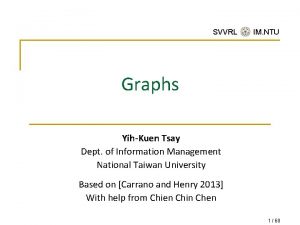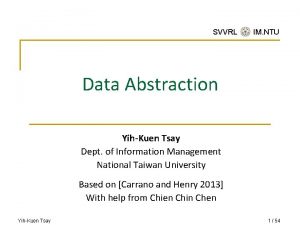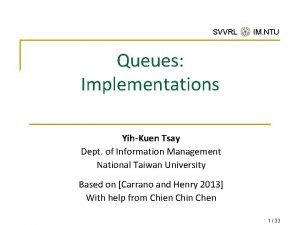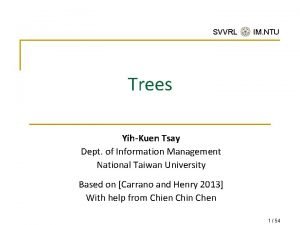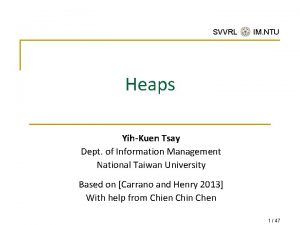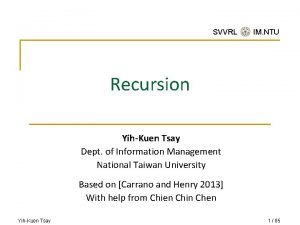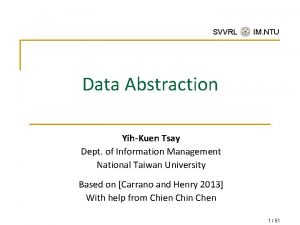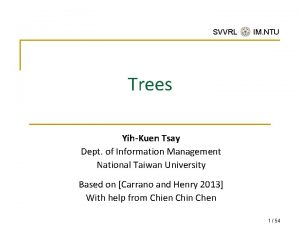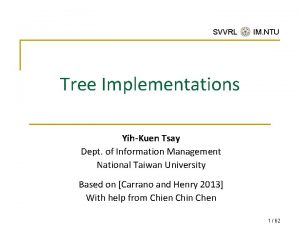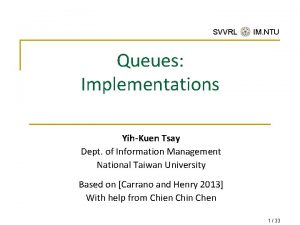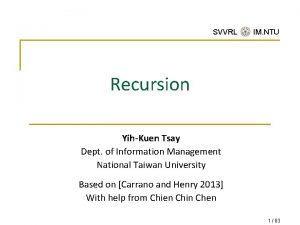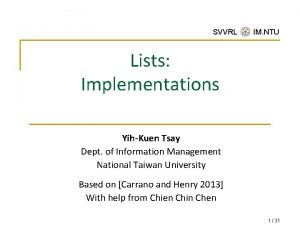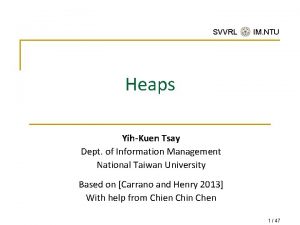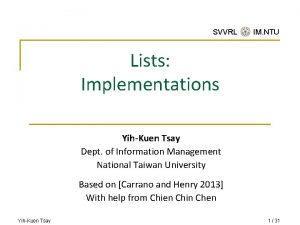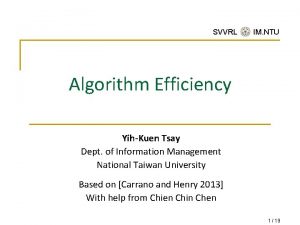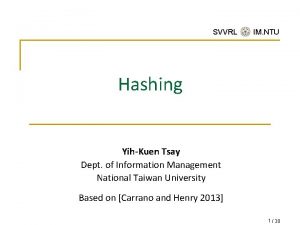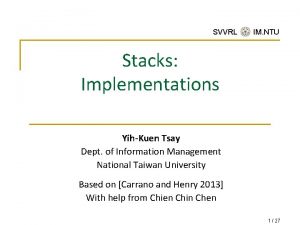SVVRL IM NTU Graphs YihKuen Tsay Dept of




































































- Slides: 68

SVVRL @ IM. NTU Graphs Yih-Kuen Tsay Dept. of Information Management National Taiwan University Based on [Carrano and Henry 2013] With help from Chien Chin Chen 1 / 68

Concepts and Terms (1/8) n n SVVRL @ IM. NTU Graphs provide a way to illustrate data and have significant applications in many fields. We will consider the kind of graphs with points that are joined by lines, like in a line graph. An ordinary line graph Source: FIGURE 20 -1 in [Carrano and Henry 2013]. Yih-Kuen Tsay DS 2017: Graphs 2 / 68

Concepts and Terms (2/8) n A graph G = (V, E) consists of two sets: q q n n SVVRL @ IM. NTU A set V of vertices, or nodes. A set E of edges , or links, that connect the vertices. A subgraph consists of a subset of a graph’s vertices and a subset of its edges (connecting the vertices in the selected subset of vertices). Two vertices are adjacent it they are joined by an edge. Yih-Kuen Tsay DS 2017: Graphs 3 / 68

Concepts and Terms (3/8) SVVRL @ IM. NTU (a) A campus map as a graph; (b) a subgraph Source: FIGURE 20 -2 in [Carrano and Henry 2013]. Yih-Kuen Tsay DS 2017: Graphs 4 / 68

Concepts and Terms (4/8) n A path is a sequence of edges that begins at one vertex and ends at another vertex. q n n n SVVRL @ IM. NTU A path may pass through the same vertex more than once. A simple path is a path that passes through a vertex at most once. A cycle is a path that begins and ends at the same vertex. A simple cycle is a cycle that does not pass through other vertices more than once. Yih-Kuen Tsay DS 2017: Graphs 5 / 68

Concepts and Terms (5/8) n n SVVRL @ IM. NTU A graph is connected if each pair of distinct vertices has a path between them (e. g. , (a)); it is disconnected, otherwise (e. g. , (b)). A graph is complete if each pair of distinct vertices has an edge between them. Source: FIGURE 20 -3 in [Carrano and Henry 2013]. Yih-Kuen Tsay DS 2017: Graphs 6 / 68

Concepts and Terms (6/8) n n SVVRL @ IM. NTU A multigraph allows multiple edges between vertices. By definition, a multipgraph is not a (simple) graph. (Most definitions of a simple graph allow self loops. ) Special kinds of graphs: (a) a multigraph; (b) a node with a self loop Source: FIGURE 20 -4 in [Carrano and Henry 2013]. Yih-Kuen Tsay DS 2017: Graphs 7 / 68

Concepts and Terms (7/8) n Weighted graph q n A graph whose edges have numeric labels. Undirected graph q n SVVRL @ IM. NTU Edges do not indicate a direction. Directed graph (digraph) q q Each edge has a direction, and is called a directed edge. A digraph may have two edges between a pair of vertices, one in each direction. Vertex y is adjacent to vertex x if there is a directed edge from x to y. A directed path is a sequence of directed edges between two vertices. Yih-Kuen Tsay DS 2017: Graphs 8 / 68

Concepts and Terms (8/8) SVVRL @ IM. NTU (a) A weighted graph; (b) a directed graph Source: FIGURE 20 -5 in [Carrano and Henry 2013]. Yih-Kuen Tsay DS 2017: Graphs 9 / 68

Graphs as ADTs (1/6) n Variations of an ADT graph are possible q Vertices may or may not contain values. n n q q n n SVVRL @ IM. NTU Many problems have no need for vertex values. Relationships among vertices is what is important. Either directed or undirected edges. Either weighted or unweighted edges. Insertion and deletion operations for graphs apply to vertices and edges. Graphs can have traversal operations. Yih-Kuen Tsay DS 2017: Graphs 10 / 68

SVVRL @ IM. NTU Graphs as ADTs (2/6) n Operations: q q Test whether a graph is empty. Get the number of vertices in a graph. Get the number of edges in a graph. Determine whether an edge exists between two given vertices. q q q Yih-Kuen Tsay Insert a vertex in a graph. Insert an edge between two given vertices. Delete a particular vertex from a graph. Delete the edge between two given vertices. Retrieve the vertex that contains a given search key. Also, traverse the graph. DS 2017: Graphs 11 / 68

Graphs as ADTs (3/6) SVVRL @ IM. NTU /** An interface for the ADT undirected, connected (? ) graph. @file Graph. Interface. h */ #ifndef _GRAPH_INTERFACE #define _GRAPH_INTERFACE template<class Label. Type> class Graph. Interface { public: /** Gets the number of vertices in this graph. @pre None. @return The number of vertices in the graph. */ virtual int get. Num. Vertices() const = 0; /** Gets the number of edges in this graph. @pre None. @return The number of edges in the graph. */ virtual int get. Num. Edges() const = 0; Yih-Kuen Tsay DS 2017: Graphs 12 / 68

Graphs as ADTs (4/6) SVVRL @ IM. NTU /** Creates an undirected edge in this graph between two vertices that have the given labels. If such vertices do not exist, creates them and adds them to the graph before creating the edge. @param start A label for the first vertex. @param end A label for the second vertex. @param edge. Weight The integer weight of the edge. @return True if the edge is created; false, otherwise. */ virtual bool add(Label. Type start, Label. Type end, int edge. Weight) = 0; /** Removes an edge from this graph. If a vertex has no other edges, it is removed from the graph since this is a connected graph. @pre None. @param start A label for the first vertex. @param end A label for the second vertex. @return True if the edge is removed; false, otherwise. */ virtual bool remove(Label. Type start, Label. Type end) = 0 Yih-Kuen Tsay DS 2017: Graphs 13 / 68

Graphs as ADTs (5/6) SVVRL @ IM. NTU /** Gets the weight of an edge in this graph. @return The weight of the specified edge. If no such edge exists, returns a negative integer. */ virtual int get. Edge. Weight(Label. Type start, Label. Type end) const = 0; /** Performs a depth-first search of this graph beginning at the given vertex and calls a given function once for each vertex visited. @param start A label for the first vertex. @param visit A client-defined function that performs an operation on or with each visited vertex. */ virtual void depth. First. Traversal(Label. Type start, void visit(Label. Type&)) = 0; Yih-Kuen Tsay DS 2017: Graphs 14 / 68

Graphs as ADTs (6/6) SVVRL @ IM. NTU /** Performs a breadth-first search of this graph beginning at the given vertex and calls a given function once for each vertex visited. @param start A label for the first vertex. @param visit A client-defined function that performs an operation on or with each visited vertex. */ virtual void breadth. First. Traversal(Label. Type start, void visit(Label. Type&)) = 0; }; // end Graph. Interface #endif Yih-Kuen Tsay DS 2017: Graphs 15 / 68

Representing Graphs (1/9) n Two most common representations of a graph: q q n n SVVRL @ IM. NTU Adjacency matrix Adjacency list An adjacency matrix for a graph with n vertices numbered 0, 1, …, n – 1 is an n by n array matrix such that matrix[i][j] indicates whether an edge exists from vertex i to vertex j. An adjacency list for a graph with n vertices numbered 0, 1, …, n – 1 is an array of n linked lists, where the i-th linked list has a node for vertex j if and only if an edge exists from vertex i to vertex j. Yih-Kuen Tsay DS 2017: Graphs 16 / 68

Representing Graphs (2/9) n n The adjacency matrix for an undirected graph is symmetrical; that is, matrix[i][j] equals matrix[j][i]. For an unweighted graph, matrix[i][j] is q q n SVVRL @ IM. NTU 1 (or true) if an edge exists from vertex i to vertex j, or 0 (or false) if no edge exists from vertex i to vertex j. For a weighted graph, matrix[i][j] is q q the weight of the edge from vertex i to vertex j, or if no edge exists from vertex i to vertex j. Yih-Kuen Tsay DS 2017: Graphs 17 / 68

Representing Graphs (3/9) SVVRL @ IM. NTU (a) A directed graph and (b) its adjacency matrix Source: FIGURE 20 -6 in [Carrano and Henry 2013]. Yih-Kuen Tsay DS 2017: Graphs 18 / 68

Representing Graphs (4/9) SVVRL @ IM. NTU (a) A weighted graph and (b) its adjacency matrix Source: FIGURE 20 -7 in [Carrano and Henry 2013]. Yih-Kuen Tsay DS 2017: Graphs 19 / 68

Representing Graphs (5/9) n In the adjacency list for a graph with n vertices numbered 0, 1, …, n – 1, the i-th list’s node can contain: q q q n SVVRL @ IM. NTU Vertex j’s value, if any, or an indication of vertex j’s identity, Edge weight, and A pointer pointing to the next node. In the adjacency list for an undirected graph, each edge is treated as if it were two directed edges in opposite directions. Yih-Kuen Tsay DS 2017: Graphs 20 / 68

Representing Graphs (6/9) SVVRL @ IM. NTU (a) A directed graph and (b) its adjacency list Source: FIGURE 20 -8 in [Carrano and Henry 2013]. Yih-Kuen Tsay DS 2017: Graphs 21 / 68

Representing Graphs (7/9) SVVRL @ IM. NTU (a) A weighted graph and (b) its adjacency list Note that each edge is treated as if it were two directed edges in opposite directions. Source: FIGURE 20 -9 in [Carrano and Henry 2013]. Yih-Kuen Tsay DS 2017: Graphs 22 / 68

Representing Graphs (8/9) n Which of these two representations is better? q n 2. Check whethere is an edge from vertex i to vertex j. Find all vertices adjacent to a given vertex i. The case of adjacency matrix: q q n Depends on how your application uses the graph. Two common operations on graphs: 1. n SVVRL @ IM. NTU Supports operation 1 more efficiently. Only need to examine the value of matrix[i][j]. The case of adjacency list: q q Supports operation 2 more efficiently. Traverse the ith linked list. Yih-Kuen Tsay DS 2017: Graphs 23 / 68

Representing Graphs (9/9) n Space requirements of the two representations: q q The adjacency matrix always has n 2 entries. The number of nodes in an adjacency list equals the number of edges in a graph (twice for an undirected graph). n n SVVRL @ IM. NTU Each node contains both a value and a pointer. The list also has n head pointer. Often requires less space than an adjacency matrix. In summary, you must consider: q q What operations are needed. Memory requirements (the number of edges). Yih-Kuen Tsay DS 2017: Graphs 24 / 68

Graph Traversals (1/3) n A graph traversal visits all the vertices that it can reach by following edges, from a given vertex. q q n SVVRL @ IM. NTU A traversal that starts at vertex v will visit all vertices w for which there is a path between v and w. A traversal visits all vertices of the graph if and only if the graph is connected. If a graph is not connected, a graph traversal will visit only a subset of the graph’s vertices. q The subset of vertices visited during a traversal that begins at a given vertex is called a connected component. Yih-Kuen Tsay DS 2017: Graphs 25 / 68

Graph Traversals (2/3) n n If a graph contains a cycle, a graph-traversal algorithm may loop indefinitely. To prevent indefinite loops, n n n Mark each vertex during a visit, and Never visit a vertex more than once. Two basic graph-traversal strategies (algorithms): q q n SVVRL @ IM. NTU depth-first search (DFS) and breadth-first search (BFS). Both DFS and BFS can apply to either directed or undirected graphs. Yih-Kuen Tsay DS 2017: Graphs 26 / 68

Graph Traversals (3/3) SVVRL @ IM. NTU (a) A depth-first search (DFS); (b) a breadth-first search (BFS) Source: FIGURE 20 -10 in [Carrano and Henry 2013]. Yih-Kuen Tsay DS 2017: Graphs 27 / 68

DFS Traversal (1/7) n n SVVRL @ IM. NTU From a given vertex v, DFS proceeds along a path from v as deeply into the graph as possible before backing up. It has a simple recursive form: // Traverses a graph beginning at vertex v by using a // depth-first search: Recursive version. dfs(v: Vertex) Mark v as visited for (each unvisited vertex u adjacent to v) dfs(u) Yih-Kuen Tsay DS 2017: Graphs 28 / 68

SVVRL @ IM. NTU DFS Traversal (2/7) dfs(v: Vertex) Mark v as visited for (each unvisited vertex u adjacent to v) dfs(u) 1 dfs(v) v 2 dfs(u) 7 u w q Yih-Kuen Tsay 8 x dfs(t) t 4 dfs(r) dfs(x) 6 3 dfs(q) dfs(w) 5 r s DS 2017: Graphs dfs(s) 29 / 68

DFS Traversal (3/7) n n SVVRL @ IM. NTU DFS is a “last visited, first explored” strategy. It has an iterative form that uses a stack. dfs(v: Vertex) s = a new empty stack s. push(v) Mark v as visited while (!s. is. Empty()) { if (no unvisited vertices are adjacent to the vertex on the top of the stack) s. pop() // Backtrack else { Select an unvisited vertex u adjacent to the vertex on the top of the stack s. push(u) Mark u as visited } Yih-Kuen Tsay DS 2017: Graphs } 30 / 68

SVVRL @ IM. NTU DFS Traversal (4/7) 1 v dfs(v) 2 8 7 u w x sr q t xu w v 6 3 q t 4 stack 5 r Yih-Kuen Tsay s DS 2017: Graphs 31 / 68

DFS Traversal (5/7) SVVRL @ IM. NTU A connected graph with cycles Source: FIGURE 20 -11 in [Carrano and Henry 2013]. Yih-Kuen Tsay DS 2017: Graphs 32 / 68

SVVRL @ IM. NTU DFS Traversal (6/7) 2 1 3 9 6 8 4 5 7 A depth-first traversal of the graph in Figure 20 -11 Source: FIGURE 20 -11 in [Carrano and Henry 2013]. Yih-Kuen Tsay DS 2017: Graphs 33 / 68

DFS Traversal (7/7) SVVRL @ IM. NTU A depth-first traversal of the graph in Figure 20 -11 Source: FIGURE 20 -12 in [Carrano and Henry 2013]. Yih-Kuen Tsay DS 2017: Graphs 34 / 68

BFS Traversal (1/4) n n SVVRL @ IM. NTU BFS visits every vertex adjacent to a vertex v that it can before visiting any other vertex. It is a “first visited, first explored” strategy, and can be implemented in an iterative form, using a queue. bfs(v: Vertex) q = a new empty queue q. enqueue(v) Mark v as visited while (!q. is. Empty()) { w = q. peek. Front() q. dequeue() for (each unvisited vertex u adjacent to w) { Mark u as visited q. enqueue(u) } } Yih-Kuen Tsay DS 2017: Graphs 35 / 68

SVVRL @ IM. NTU BFS Traversal (2/4) v bfs(v) 3 2 u w 4 x 6 5 q t 7 8 r s queue Yih-Kuen Tsay 1 v u w x q t r s DS 2017: Graphs 36 / 68

SVVRL @ IM. NTU BFS Traversal (3/4) 2 1 5 4 6 9 8 7 3 A breadth-first traversal of the graph in Figure 20 -11 Source: FIGURE 20 -11 in [Carrano and Henry 2013]. Yih-Kuen Tsay DS 2017: Graphs 37 / 68

BFS Traversal (4/4) SVVRL @ IM. NTU A breadth-first traversal of the graph in Figure 20 -11 Source: FIGURE 20 -13 in [Carrano and Henry 2013]. Yih-Kuen Tsay DS 2017: Graphs 38 / 68

Topological Sorting (1/6) n SVVRL @ IM. NTU Topological order: q A list of vertices in a directed graph without cycles (like the one below) such that vertex x precedes vertex y if there is a directed edge from x to y in the graph. A directed graph without cycles Source: FIGURE 20 -14 in [Carrano and Henry 2013]. Yih-Kuen Tsay DS 2017: Graphs 39 / 68

Topological Sorting (2/6) n SVVRL @ IM. NTU Several topological orders are possible for a given graph. The graph in Fig. 20 -14 arranged in two different topological orders Source: FIGURE 20 -15 in [Carrano and Henry 2013]. Yih-Kuen Tsay DS 2017: Graphs 40 / 68

Topological Sorting (3/6) n Topological sorting: q n Arranging the vertices into a topological order. top. Sort 1 1. 2. 3. 4. n SVVRL @ IM. NTU Find a vertex that has no successor. Add the vertex to the beginning of a list. Remove that vertex from the graph, as well as all edges that lead to it. Repeat the previous steps until the graph is empty. When the loop ends, the list of vertices will be in topological order. Yih-Kuen Tsay DS 2017: Graphs 41 / 68

Topological Sorting (4/6) a b d SVVRL @ IM. NTU c e f g List: Yih-Kuen Tsay a g d b e c f DS 2017: Graphs 42 / 68

Topological Sorting (5/6) SVVRL @ IM. NTU top. Sort 2(the. Graph: Graph, a. List: list) s = a new empty stack for (each vertex v in the. Graph) if (v has no predecessors) { s. push(v) Mark v as visited } while (!s. is. Empty()) { if (all vertices adjacent to the vertex on the top of the stack have been visited) { s. pop(v) a. List. insert(1, v) } else { Select an unvisited vertex u adjacent to the vertex on the top of the stack s. push(u) Mark u as visited } } Yih-Kuen Tsay DS 2017: Graphs 43 / 68

SVVRL @ IM. NTU Topological Sorting (6/6) a b d g 1. 2. c e List: cf e d g b a f a b g d e f c stack Push (and mark) all vertices that have no predecessor onto a stack. DFS while loop Yih-Kuen Tsay DS 2017: Graphs 44 / 68

Spanning Trees (1/7) n n SVVRL @ IM. NTU A tree is an undirected connected graph without cycles. A spanning tree of a connected undirected graph G is a subgraph of G that contains all of G’s vertices and enough of its edges to form a tree. Yih-Kuen Tsay DS 2017: Graphs 45 / 68

Spanning Trees (2/7) SVVRL @ IM. NTU n There may be several spanning trees for a given graph. To obtain a spanning tree from a connected undirected graph with cycles, one may remove edges until there are no cycles. n Detecting a cycle in an undirected connected graph: n q q q A connected undirected graph that has n vertices must have at least n – 1 edges. A connected undirected graph that has n vertices and exactly n – 1 edges cannot contain a cycle. A connected undirected graph that has n vertices and more than n – 1 edges must contain at least one cycle. You can determine whether a connected graph contains a cycle simply by counting its vertices and edges. Yih-Kuen Tsay DS 2017: Graphs 46 / 68

SVVRL @ IM. NTU Spanning Trees (3/7) n Two algorithms for determining a spanning tree of a graph: q q The DFS spanning tree. THE BFS spanning tree. Yih-Kuen Tsay DS 2017: Graphs 47 / 68

Spanning Trees (4/7) n To create a depth-first search (DFS) spanning tree, q q n SVVRL @ IM. NTU Traverse the graph using a depth-first search and mark the edges that you follow. After the traversal is complete, the graph’s vertices and marked edges form the spanning tree. To create a breath-first search (BFS) spanning tree, q q Traverse the graph using a bread-first search and mark the edges that you follow. When the traversal is complete, the graph’s vertices and marked edges form the spanning tree. Yih-Kuen Tsay DS 2017: Graphs 48 / 68

Spanning Trees (5/7) SVVRL @ IM. NTU A DFS spanning tree for the graph in Fig. 20 -11 Source: FIGURE 20 -20 in [Carrano and Henry 2013]. Yih-Kuen Tsay DS 2017: Graphs 49 / 68

SVVRL @ IM. NTU Spanning Trees (6/7) n The DFS spanning tree rooted at vertex a. root (1) a b (2) (8) c i (5) f Yih-Kuen Tsay (6) h (3) e g d (4) DS 2017: Graphs (7) fe g h d c ib a stack 50 / 68

Spanning Trees (7/7) SVVRL @ IM. NTU A BFS spanning tree for the graph in Fig. 20 -11 Source: FIGURE 20 -21 in [Carrano and Henry 2013]. Yih-Kuen Tsay DS 2017: Graphs 51 / 68

SVVRL @ IM. NTU Minimum Spanning Trees (1/4) n Suppose you are building a telephone system of a country. q q n Vertices: cities. Edges: weighted, the installation cost of the telephone line. Cost of the spanning tree: q Sum of the costs of the edges of the spanning tree. 6 a b 2 7 9 c 4 i 3 e 8 f 2 g h 4 5 1 d Source: FIGURE 20 -22 in [Carrano and Henry 2013]. Yih-Kuen Tsay DS 2017: Graphs 52 / 68

SVVRL @ IM. NTU Minimum Spanning Trees (2/4) n A minimum spanning tree of a connected undirected graph has a minimal edge-weight sum. q n A particular graph could have several minimum spanning trees. Prim’s algorithm: q A method finds a minimum spanning tree that begins at any vertex. Yih-Kuen Tsay DS 2017: Graphs 53 / 68

SVVRL @ IM. NTU Minimum Spanning Trees (3/4) // Determines a minimum spanning tree for a weighted, // connected, undirected graph whose weights are // nonnegative, beginning with any vertex v. prims. Algorithm(v: Vertex) Mark vertex v as visited and include it in the minimum spanning tree while (there are unvisited vertices) { Find the least-cost edge (v, u) from a visited vertex v to some unvisited vertex u Mark u as visited Add the vertex u and the edge (v, u) to the minimum spanning tree } Yih-Kuen Tsay DS 2017: Graphs 54 / 68

SVVRL @ IM. NTU Minimum Spanning Trees (4/4) prims. Algorithm(a) 6 a b 2 7 9 c 4 i 3 e 8 f Yih-Kuen Tsay 2 h 4 5 1 d g DS 2017: Graphs 55 / 68

Shortest Paths (1/6) SVVRL @ IM. NTU (a) A weighted directed graph and (b) its adjacency matrix Source: FIGURE 20 -24 in [Carrano and Henry 2013]. Yih-Kuen Tsay DS 2017: Graphs 56 / 68

Shortest Paths (2/6) n A map of airline routes: q q q n SVVRL @ IM. NTU The vertices are cities. The edges indicate existing flights between cities. The edge weights represent the mileage between cities. Shortest path between two vertices in a weighted graph is: q The path that has the smallest sum of its edge weights. Yih-Kuen Tsay DS 2017: Graphs 57 / 68

SVVRL @ IM. NTU Shortest Paths (3/6) n Dijkstra’s Algorithm: q n Find the shortest paths between a given origin and all other vertices. For convenience, the starting vertex (origin) is labeled 0, and the other vertices are labeled from 1 to n-1. Adjacency matrix 8 1 2 3 4 0 ∞ 8 ∞ 9 4 1 ∞ ∞ 2 ∞ 3 ∞ ∞ 2 ∞ 7 4 ∞ ∞ 1 ∞ ∞ 2 0 4 9 1 2 1 3 2 3 Yih-Kuen Tsay 0 7 4 1 DS 2017: Graphs 58 / 68

Shortest Paths (4/6) n Dijkstra’s algorithm uses: q q n SVVRL @ IM. NTU A set vertex. Set of selected vertices. An array weight, where weight[v] is the weight of the shortest path from vertex 0 to vertex v that passes through vertices in vertex. Set. Initially, vertex. Set contains only vertex 0, and weight contains the weights of the single-edge paths from vertex 0 to all other vertices. Yih-Kuen Tsay DS 2017: Graphs 59 / 68

Shortest Paths (5/6) n After initialization, you find a vertex v that is not in vertex. Set and that minimizes weight[v]. q q q n SVVRL @ IM. NTU Add v to vertex. Set. For all vertices u not in vertex. Set, you check the values weight[u] to ensure that they are indeed minimums. weight[u] = min{ weight[u], weight[v] + matrix[v][u] } The final values in weight are the weights of the shortest path. Yih-Kuen Tsay DS 2017: Graphs 60 / 68

SVVRL @ IM. NTU Shortest Paths (6/6) Adjacency matrix 8 0 1 2 3 4 0 ∞ 8 ∞ 9 4 1 ∞ ∞ 2 ∞ 3 ∞ ∞ 2 ∞ 7 4 ∞ ∞ 1 ∞ ∞ 2 0 4 9 1 2 1 3 2 3 7 1 4 Source: FIGURE 20 -25 in [Carrano and Henry 2013]. Yih-Kuen Tsay DS 2017: Graphs 61 / 68

Eulerian Circuits (1/4) n SVVRL @ IM. NTU An Eulerian circuit is a cycle (circuit) that begins at a vertex v, passes through every edge exactly once, and terminates at v. (a) Euler’s bridge problem and (b) its multigraph representation Source: FIGURE 20 -27 in [Carrano and Henry 2013]. Yih-Kuen Tsay DS 2017: Graphs 62 / 68

SVVRL @ IM. NTU Eulerian Circuits (2/4) n n n For a connected graph, an Eulerian circuit exists if and only if each vertex touches an even number of edges. Does the graph has Euler circuit? Find an Eulerian circuit: q q a b c d e f g h i j k l Use a depth-first search that marks edges instead of vertices as they are traversed. Eulerian circuit: a b e f j i h d c g h k l i e d a When you find a cycle, launch a new traversal beginning with the first vertex along the cycle that touches an unvisited edge. Yih-Kuen Tsay DS 2017: Graphs 63 / 68

Eulerian Circuits (3/4) SVVRL @ IM. NTU The steps to determine an Euler circuit applied to Fig. 20 -29 Source: FIGURE 20 -30 in [Carrano and Henry 2013]. Yih-Kuen Tsay DS 2017: Graphs 64 / 68

Eulerian Circuits (4/4) SVVRL @ IM. NTU The steps to determine an Euler circuit applied to Fig. 20 -29 Source: FIGURE 20 -30 in [Carrano and Henry 2013]. Yih-Kuen Tsay DS 2017: Graphs 65 / 68

Some Difficult Problems n The traveling salesman problem (TSP): q q n SVVRL @ IM. NTU A Hamiltonian circuit begins at a vertex v, passes through every vertex exactly once, and terminates at v. For a weighted graph, find a Hamiltonian circuit with the least weight expense. The four-color problem. q q A planar graph can be drawn so that no two edges cross. It has been proven that a planar graph can be colored with four colors so that no adjacent vertices have the same color. Yih-Kuen Tsay DS 2017: Graphs 66 / 68

SVVRL @ IM. NTU Summary (1/2) n n The most common representations of a graph use either an adjacency matrix or an adjacency list. Graph traversals: q Depth-first search goes as deep into the graph as it can before backtracking. n q Uses a stack. Bread-first search visits all possible adjacent vertices before traversing further into the graph. n Yih-Kuen Tsay Uses a queue. DS 2017: Graphs 67 / 68

SVVRL @ IM. NTU Summary (2/2) n n Topological sorting produces a linear order of the vertices in a directed graph without cycles. A spanning tree of a connected undirected graph is a subgraph that contains all the graph’s vertices and enough of its edges to form a tree. A minimum spanning tree for a weighted undirected graph is a spanning tree whose edge-weight sum is minimal. The shortest path between two vertices in a weighted directed graph is the path that has the smallest sum of its edge weights. Yih-Kuen Tsay DS 2017: Graphs 68 / 68
 Yih-kuen tsay
Yih-kuen tsay Elaine tsay
Elaine tsay Graphs that enlighten and graphs that deceive
Graphs that enlighten and graphs that deceive Degree and leading coefficient
Degree and leading coefficient Testability tips in state graphs
Testability tips in state graphs Speed and velocity
Speed and velocity La revenue dept
La revenue dept Florida dept of agriculture and consumer services
Florida dept of agriculture and consumer services Gome dept
Gome dept Finance departments
Finance departments Dept ind onegov
Dept ind onegov Pt dept logistik
Pt dept logistik Rowan county dss child protective services
Rowan county dss child protective services Firefighter interview tips
Firefighter interview tips Dept. name of organization (of affiliation)
Dept. name of organization (of affiliation) Dept of finance and administration
Dept of finance and administration Oxford dept of continuing education
Oxford dept of continuing education Florida dept of agriculture and consumer services
Florida dept of agriculture and consumer services Nyttofunktion
Nyttofunktion Worcester inspectional services
Worcester inspectional services Albany county dept of social services
Albany county dept of social services Nys dept of homeland security
Nys dept of homeland security Maine dept of agriculture
Maine dept of agriculture Vaginal dept
Vaginal dept Dept. name of organization
Dept. name of organization Dept nmr spectroscopy
Dept nmr spectroscopy Nebraska dept of agriculture
Nebraska dept of agriculture Dept of education
Dept of education Dept a
Dept a Gome dept
Gome dept Dept. name of organization (of affiliation)
Dept. name of organization (of affiliation) Affiliate disclodures
Affiliate disclodures Dept of education
Dept of education Gome dept
Gome dept Ohio employment first
Ohio employment first Florida department of agriculture and consumer services
Florida department of agriculture and consumer services Ee dept iitb
Ee dept iitb Dept c13 nmr
Dept c13 nmr Central islip fire department
Central islip fire department Hoe dept
Hoe dept Mn dept of education
Mn dept of education Ntu student dashboard
Ntu student dashboard Hwu timetable
Hwu timetable Ntu scambiatore
Ntu scambiatore Lt19 ntu
Lt19 ntu National taiwan university civil engineering
National taiwan university civil engineering Belgrave ntu
Belgrave ntu Ntu microsoft
Ntu microsoft Ntu csie
Ntu csie Ntu google map
Ntu google map Lams ntu
Lams ntu Graduate institute of electronics engineering
Graduate institute of electronics engineering Nora ntu
Nora ntu Cati lab ntu
Cati lab ntu Ntu col
Ntu col Ntu heat transfer
Ntu heat transfer Ntu vpn
Ntu vpn Ntu method
Ntu method Ntu im
Ntu im Csie.ntu
Csie.ntu Ntu ppt template
Ntu ppt template Vpn hyundai
Vpn hyundai Csie.ntu
Csie.ntu Bioenvironmental
Bioenvironmental Ers ntu
Ers ntu Marginal fail ntu
Marginal fail ntu Ntu
Ntu Ntu
Ntu Ntu giee
Ntu giee
